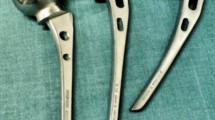Abstract
Dr. Marius N. Smith-Petersen, in Boston, MA, USA, introduced the mould arthroplasty (1923). He used a reactive synovial-like membrane that he found had developed around a piece of glass he had removed from a workman’s back, which had been imbedded there for a year. The original design was a ball-shaped, hollow hemisphere of glass that could fit over the femoral head of the hip joint. The objective was to stimulate cartilage regeneration on both sides of the moulded glass joint. Smith-Peterson intended to remove the glass after the cartilage had been restored. Glass provided a new, smooth surface for movement, and although proving biocompatible, it could not withstand the stresses of walking and quickly failed. Smith-Petersen succeeded in his endeavour by using Vitallium alloy.












Similar content being viewed by others
References
Smith-Petersen M (1967) The classic: treatment of fractures of the neck of the femur by internal fixation. Clin Orthop Relat Res 54:3–11
Smith-Petersen M (1948) Evolution of mould arthroplasty of the hip joint. J Bone Joint Surg Br 30B(1):59
Smith-Petersen M, Larson C, Aufranc OE (1969) The classic: osteotomy of the spine for correction of flexion deformity in rheumatoid arthritis. Clin Orthop Relat Res 66:6–9
Smith-Petersen M, Larson C, Cochran W (2008) The classic: local chemotherapy with primary closure of septic wounds by means of drainage and irrigation cannulae. Clin Orthop Relat Res 466:104–112
Smith-Petersen MN (1936) Treatment of malum coxae senilis, old slipped upper femoral epiphysis, intrapelvic protrusion of the acetabulum, and coxa plana by means of acetabuloplasty. J Bone Joint Surg Am 18:869–880
Dr. M. N. Smith-Petersen, 1886–1953. (1953) J Bone Joint Surg Br.;35:482–484.
Smith-Petersen MN (1953) Lancet 265:145–146
Marius Nygaard Smith-Petersen, 1886–1953. (1953) N Engl J Med.;249:210–211.
Smith-Petersen MN (1953) Br Med J 2:48
Semb C (1953) Professor Marius Nygaard Smith-Petersen in memoriam. Tidsskr Nor Laegeforen 73:605
Author information
Authors and Affiliations
Corresponding author
Rights and permissions
About this article
Cite this article
Hernigou, P. Smith–Petersen and early development of hip arthroplasty. International Orthopaedics (SICOT) 38, 193–198 (2014). https://doi.org/10.1007/s00264-013-2080-5
Received:
Accepted:
Published:
Issue Date:
DOI: https://doi.org/10.1007/s00264-013-2080-5




